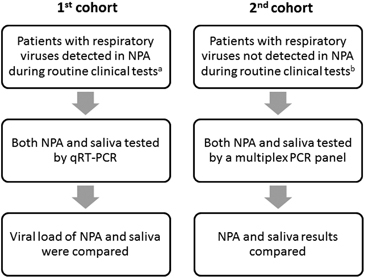Figures & data
Figure 1 Study design. nasopharyngeal aspirate, NPA; quantitative PCR with reverse transcription, qRT-PCR. aRoutine clinical testing was performed using antigen detection by the DFA, which included the influenza A and B viruses, parainfluenza virus types 1–3, respiratory syncytial virus, human metapneumovirus and adenovirus. From 1 March to 8 April 2015 (during the peak influenza A virus season), monoplex real-time RT-PCR for the influenza A M gene was performed for patients admitted to the general medical ward. bPatients whose NPA specimens either tested negative for respiratory viruses by DFA or had insufficient NPCs for DFA during routine clinical testing. Insufficient NPCs is defined as <20 NPCs in the entire well.

Table 1 Primers and probes used in the quantitative reverse transcription PCR
Figure 2 Viral loads in the NPA and the saliva specimens for all patients in the first cohort. The number of patients infected with each of the respiratory viruses is outlined in Table . (A) Comparison of viral loads between the NPA and saliva specimens. (B) Comparison of the saliva viral load of influenza A and influenza B in patients with saliva collected before and after oseltamivir treatment. (C) Comparison of the saliva viral loads in patients with or without pneumonia. Medians, quartiles, and ranges are shown. nasopharyngeal aspirate, NPA.

Table 2 Detection of viruses using quantitative real-time reverse transcription PCR in the first cohort of patients
Table 3 Detection of respiratory viruses in nasopharyngeal aspirate and saliva using NxTAG Respiratory Pathogen Panel in the second cohort of patientsFootnotea
Table 4 Respiratory viruses detected using multiplex PCR panel in the second cohort of patientsFootnotea
Table 5 Nine patients with additional respiratory viruses detected only in their saliva for the second cohort of patients
